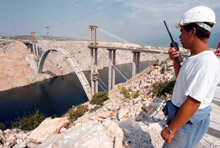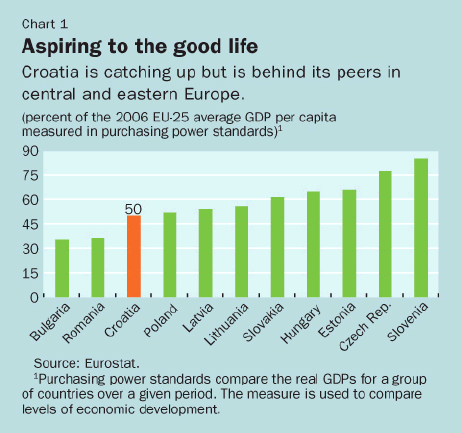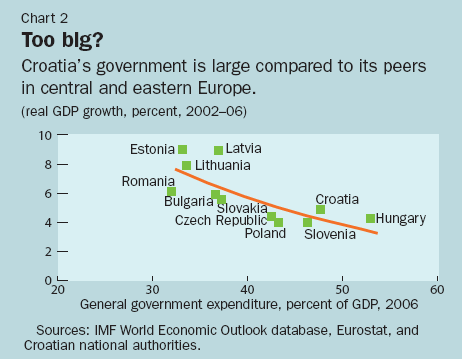
Typical street scene in Santa Ana, El Salvador. (Photo: iStock)
IMF Survey: Croatia: Figuring Out How to Grow Faster
August 13, 2007
- With current policies, Croatia can sustain growth of 4-4½ percent per year
- Business environment holds key to higher growth
- Reforms should seek to reduce red tape, legal uncertainties, corruption
Croatia has enjoyed solid economic growth in recent years but it could do even better.

Bridge repair in Croatia where, IMF says, improvements to business environment are critical to increasing potential growth (photo: Matko Biljak/Reuters)
TRANSITION ECONOMIES
Real GDP growth has averaged 4¾ percent over the past five years, below the average of nearly 6 percent achieved by peer countries in central and eastern Europe that recently joined the EU. With Croatia also on track to join the EU in a few years' time, the government aspires to higher growth as a means to catch up faster with living standards in the EU (see Chart 1). But how can it realize its goals?

Research indicates that Croatia's potential growth rate (the rate at which the economy can grow on a sustained basis) is 4-4½ percent. This suggests that recent economic growth has exceeded the economy's potential. Consequently, reforms are needed to raise the economy's overall productivity if Croatia is to avoid a slowdown.
Croatia at a glance
Capital: Zagreb
Area: 56,538 square km.
Population: 4.4 million
GDP per capita: $9,664 (2006)
Main source of foreign-exchange earnings: tourism
Looking at factors supporting growth, Croatia has many natural advantages, including ready access to central, Mediterranean, and southeastern Europe, and a long and beautiful coastline that underpins the vital tourism industry. Croatia also compares favorably with other transition economies in terms of its very open economy, its well-developed banking system, strong public investment and infrastructure, and low inflation over the past decade. And with living standards well below those in the euro area, Croatia still has considerable scope for catch-up growth.
So what is holding growth back?
Export performance, which has been weaker in Croatia compared to its peers in central and eastern Europe, provides some clues. Over the past five years, Croatia's real exports of goods and services increased by an average 6 percent annually, significantly below the peer country average of over 10 percent.
In a similar vein, Croatia has also done less well in terms of attracting new investors. Although total foreign direct investment (FDI) in Croatia is close to the regional average, a disproportionately high share has come from privatizations or investment in the financial sector. The number of "greenfield" FDI projects—which are especially good for growth—remains small.
Why is that? Survey evidence consistently points to a difficult business environment for both domestic and foreign investors. This may be linked to the fact that the government is very large (see Chart 2). General government spending as a share of GDP exceeds the regional average by several percentage points, with only Hungary showing higher government spending.

Identifying constraints
IMF staff recently carried out a "growth diagnostic" exercise to identify binding constraints on growth. The study showed that growth is not held back, as is often the case, by financing problems or a lack of ideas for investment.
Recent business environment reforms
The authorities have already taken several important steps to simplify procedures at the central government level:
The hitro.hr service launched in 2005 introduced both a "one-stop shop" to establish a business and a platform for a variety of "e-government" services.
To assist foreign investors, the Trade and Investment Promotion Agency was established in late 2005.
A working group (with USAID assistance) is preparing a "regulatory guillotine" to propose elimination of obsolete and/or unnecessary regulations and recently issued its initial recommendations.
A project is under way (with World Bank and EU assistance) to improve the land cadastre and registry system. The government has also established "entrepreneurial zones" on land free of ownership uncertainty to provide businesses with space, infrastructure and easier administrative procedures.
Rather, Croatia is not yet as good a place in which to do business as it could be, even allowing for recent improvements (see Box 2). The diagnostic highlights the microeconomic problems stemming from the public sector: an inefficient bureaucracy and a high regulatory burden, problems with property rights, and corruption.
• The administrative and regulatory burden is particularly heavy at the local level, with investors often facing numerous non-transparent fees and delays in obtaining necessary permits. Lingering land ownership uncertainties have also hindered investment in some regions.
• Employment protection legislation is strict by regional and OECD standards, especially for temporary workers. While this legislation has helped protect jobs for existing employees it has also acted as a severe disincentive to new job creation.
• Contract enforcement is slow. The European Commission has warned that creditor and property rights are undermined by "slow and inefficient court proceedings, poor case management and low administrative and professional capacity." Transparency International's corruption perceptions index indicates that Croatia suffers from "serious," though not "severe," levels of corruption, a finding corroborated by other survey evidence.
Role of the state
The analysis highlights how improvements to the business environment are critical to increasing Croatia's potential growth. In addition, potential growth would benefit from a reduction in the still-significant role of the state in the economy, in particular by reducing the ratio of public expenditure to GDP to levels more in line with regional standards, and by eliminating the drain on public resources from state-owned enterprises that have yet to be restructured.
Clearly, if Croatia is to keep up with the more successful new EU members, the pace of reform needs to accelerate. Encouragingly, the government is aware of these problem areas. And the EU accession process is providing additional impetus for new measures in some of the more difficult areas that the authorities have already targeted for reform.
This article is based on "Economic Growth in Croatia: Potential and Constraints," by David Moore and Athanasios Vamvakidis, IMF Working Paper No. 07/198, available at: http://www.imf.org/external/pubs/ft/wp/2007/wp07198.pdf


